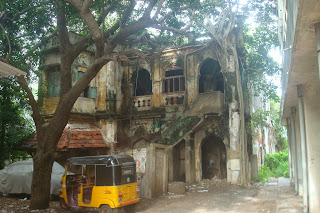In the one-and-a-half years since it was published, I had managed to get only half-way through the first chapter of "Tamarind City" until last week. Over the weekend, I raced through the rest of it, wondering what it was that kept me from finishing this much, much earlier.
I haven't been able to find a solid reason, but there was a vague feeling that by reading the book, I will be biased about what I write on this blog. Towards the end of the last week, I figured out that I was neither writing this blog going nor reading the book and I wanted to get at least one of that done.
Bishwanath Ghosh has an easy familiarity with the city, coupled with the eye of the outsider, that helps him spot interesting quirks in what the lay Chennaite would consider commonplace. Having been a fellow traveller on at least one of the walks that he had taken, it was easy for me to visualize Bishwanath taking in the details and then highlighting that one aspect which brings the city to life for an outsider - and for anyone who hasn't bothered to look around their own living space.
Most of all, it has spurred me to write again, and to remind me that I have to observe and not just see. The blog starts again. And you, if you have any interest in the people of Chennai, do get the book!








































